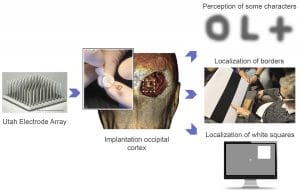With the purpose of To restore sight at least partially to the blind, various research teams are trying to develop true bionic eyes with varying degrees of success. The main challenge for an artificial eye is the number of tiny nerve endings to be simulated (the human optic nerve contains millions of them). A newly developed artificial eye, for example, it only allowed to obtain images of 100 pixels. Recently, Spanish researchers have tried another approach: avoiding the eyes to connect directly with the visual cortex of the brain. The image is obtained by means of a camera placed on glasses before being converted into suitable electrical signals.
To capture the images to be converted, the user has glasses with a central camera. A kind of artificial retina. The researchers built on work previously done by Australia’s Monash University and the Australian Eye Research Center, but used a different implant implanted directly into brain tissue.
It is true that the camera is not used at the moment to transmit a complete image, but variations of light that allow you to distinguish shapes and objects. To do this, the light captured in front of the glasses is converted into electrical signals that are transmitted to the implant placed in the user’s brain, a three-dimensional array of 96 microelectrodes. The study, led by Professor Eduardo Fernández Jover, was published in the journal The clinical research journal.
Recreate the vision “pixel by pixel” …
The implant is 4mm wide and each of the small electrodes is 1.5mm long. These are inserted into brain tissue so that they can both stimulate and monitor the electrical activity of neurons in the visual cortex, located in the larger cerebral cortex. This stimulation allows the person to perceive the light patterns transmitted by the artificial retina.
Last year, a 1000-electrode version of the setup was successfully tested in primates, although the animals were not blind. More recently, however, a team from Spain’s Miguel Hernández University tested the current version on a 57-year-old woman who had been blind for more than 16 years. After an initial phase in which he learned to interpret the images produced by the device, he was able to identify the letters and silhouettes of certain objects.
In the following video, the patient can roughly distinguish where on a virtual screen movement takes place (by stimulating the visual cortex):
The implant did not otherwise affect the function of the cerebral cortex, nor did it stimulate adjacent non-target neurons. Additionally, it required a much lower electrical current than similar electrode arrays placed on the surface of the brain (used in previous studies), making it potentially safer to use.

When individual microelectrodes were stimulated at or above a certain threshold, the subject generally reported that the evoked perceptions were colorless (white). ” For currents below the threshold in question (Nevertheless), the phosphenes were sometimes slightly colored, yellowish, or sepia Write to the researchers in your document.
There is still a lot of work to be done before the technology can be used on a practical level, so scientists are now recruiting blind volunteers for new experiments. These could consist of stimulating a greater number of neurons simultaneously, in order to produce more complex and detailed images.
Video presenting the investigation:
Sources: The clinical research journal, R&I world

Introvert. Beer guru. Communicator. Travel fanatic. Web advocate. Certified alcohol geek. Tv buff. Subtly charming internet aficionado.